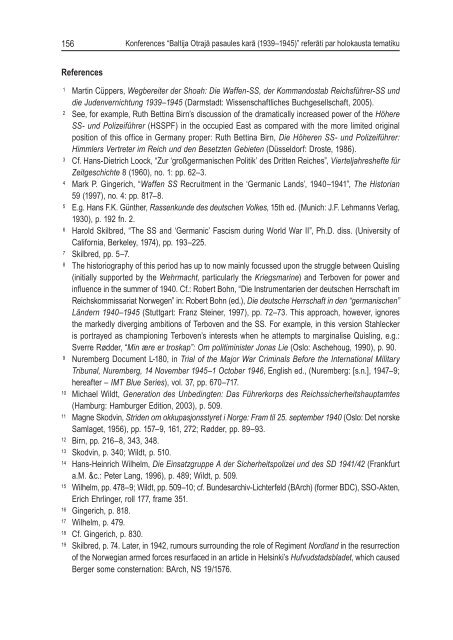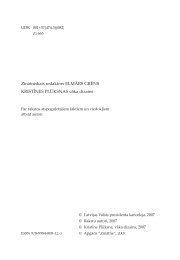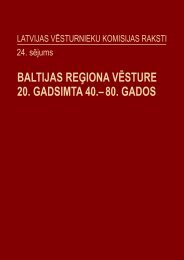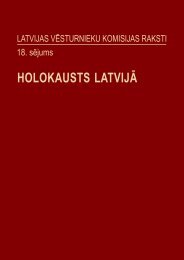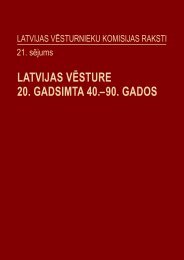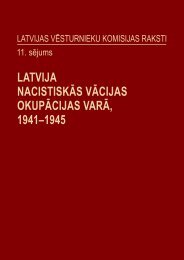Latvijas Vēsturnieku komisijas raksti - 23.sējums
Latvijas Vēsturnieku komisijas raksti - 23.sējums
Latvijas Vēsturnieku komisijas raksti - 23.sējums
You also want an ePaper? Increase the reach of your titles
YUMPU automatically turns print PDFs into web optimized ePapers that Google loves.
156 Konferences “Baltija Otrajā pasaules karā (1939–1945)” referāti par holokausta tematiku<br />
References<br />
1 Martin Cüppers, Wegbereiter der Shoah: Die Waffen-SS, der Kommandostab Reichsführer-SS und<br />
die Judenvernichtung 1939–1945 (Darmstadt: Wissenschaftliches Buchgesellschaft, 2005).<br />
2 See, for example, Ruth Bettina Birn’s discussion of the dramatically increased power of the Höhere<br />
SS- und Polizeiführer (HSSPF) in the occupied East as compared with the more limited original<br />
position of this office in Germany proper: Ruth Bettina Birn, Die Höheren SS- und Polizeiführer:<br />
Himmlers Vertreter im Reich und den Besetzten Gebieten (Düsseldorf: Droste, 1986).<br />
3 Cf. Hans-Dietrich Loock, “Zur ‘großgermanischen Politik’ des Dritten Reiches”, Vierteljahreshefte für<br />
Zeitgeschichte 8 (1960), no. 1: pp. 62–3.<br />
4 Mark P. Gingerich, “Waffen SS Recruitment in the ‘Germanic Lands’, 1940–1941”, The Historian<br />
59 (1997), no. 4: pp. 817–8.<br />
5 E.g. Hans F.K. Günther, Rassenkunde des deutschen Volkes, 15th ed. (Munich: J.F. Lehmanns Verlag,<br />
1930), p. 192 fn. 2.<br />
6 Harold Skilbred, “The SS and ‘Germanic’ Fascism during World War II”, Ph.D. diss. (University of<br />
California, Berkeley, 1974), pp. 193–225.<br />
7 Skilbred, pp. 5–7.<br />
8 The historiography of this period has up to now mainly focussed upon the struggle between Quisling<br />
(initially supported by the Wehrmacht, particularly the Kriegsmarine) and Terboven for power and<br />
influence in the summer of 1940. Cf.: Robert Bohn, “Die Instrumentarien der deutschen Herrschaft im<br />
Reichskommissariat Norwegen” in: Robert Bohn (ed.), Die deutsche Herrschaft in den “germanischen”<br />
Ländern 1940–1945 (Stuttgart: Franz Steiner, 1997), pp. 72–73. This approach, however, ignores<br />
the markedly diverging ambitions of Terboven and the SS. For example, in this version Stahlecker<br />
is portrayed as championing Terboven’s interests when he attempts to marginalise Quisling, e.g.:<br />
Sverre Rødder, “Min ære er troskap”: Om politiminister Jonas Lie (Oslo: Aschehoug, 1990), p. 90.<br />
9 Nuremberg Document L-180, in Trial of the Major War Criminals Before the International Military<br />
Tribunal, Nuremberg, 14 November 1945–1 October 1946, English ed., (Nuremberg: [s.n.], 1947–9;<br />
hereafter – IMT Blue Series), vol. 37, pp. 670–717.<br />
10 Michael Wildt, Generation des Unbedingten: Das Führerkorps des Reichssicherheitshauptamtes<br />
(Hamburg: Hamburger Edition, 2003), p. 509.<br />
11 Magne Skodvin, Striden om okkupasjonsstyret i Norge: Fram til 25. september 1940 (Oslo: Det norske<br />
Samlaget, 1956), pp. 157–9, 161, 272; Rødder, pp. 89–93.<br />
12 Birn, pp. 216–8, 343, 348.<br />
13 Skodvin, p. 340; Wildt, p. 510.<br />
14 Hans-Heinrich Wilhelm, Die Einsatzgruppe A der Sicherheitspolizei und des SD 1941/42 (Frankfurt<br />
a.M. &c.: Peter Lang, 1996), p. 489; Wildt, p. 509.<br />
15 Wilhelm, pp. 478–9; Wildt, pp. 509–10; cf. Bundesarchiv-Lichterfeld (BArch) (former BDC), SSO-Akten,<br />
Erich Ehrlinger, roll 177, frame 351.<br />
16 Gingerich, p. 818.<br />
17 Wilhelm, p. 479.<br />
18 Cf. Gingerich, p. 830.<br />
19 Skilbred, p. 74. Later, in 1942, rumours surrounding the role of Regiment Nordland in the resurrection<br />
of the Norwegian armed forces resurfaced in an article in Helsinki’s Hufvudstadsbladet, which caused<br />
Berger some consternation: BArch, NS 19/1576.


